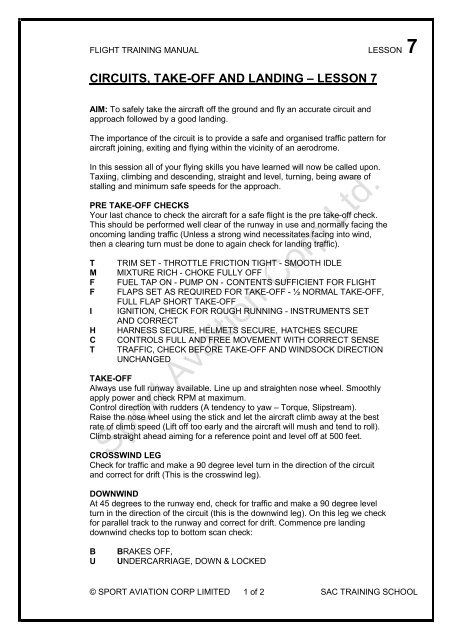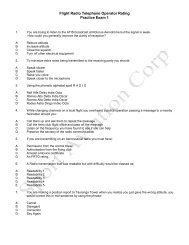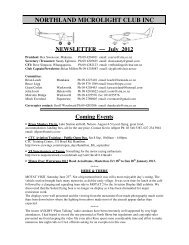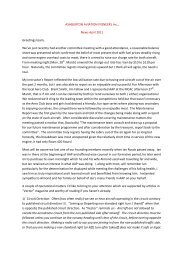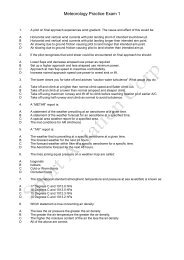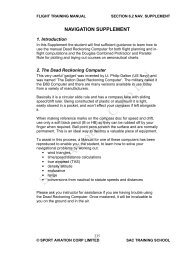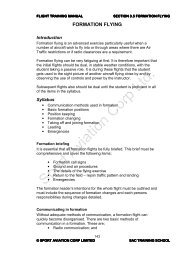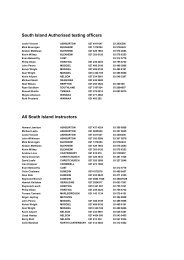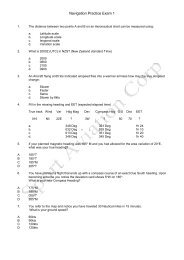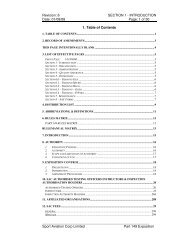circuits, take-off and landing â lesson 7 - Sport Aviation Corp
circuits, take-off and landing â lesson 7 - Sport Aviation Corp
circuits, take-off and landing â lesson 7 - Sport Aviation Corp
You also want an ePaper? Increase the reach of your titles
YUMPU automatically turns print PDFs into web optimized ePapers that Google loves.
FLIGHT TRAINING MANUAL LESSON 7<br />
CIRCUITS, TAKE-OFF AND LANDING – LESSON 7<br />
AIM: To safely <strong>take</strong> the aircraft <strong>off</strong> the ground <strong>and</strong> fly an accurate circuit <strong>and</strong><br />
approach followed by a good l<strong>and</strong>ing.<br />
The importance of the circuit is to provide a safe <strong>and</strong> organised traffic pattern for<br />
aircraft joining, exiting <strong>and</strong> flying within the vicinity of an aerodrome.<br />
In this session all of your flying skills you have learned will now be called upon.<br />
Taxiing, climbing <strong>and</strong> descending, straight <strong>and</strong> level, turning, being aware of<br />
stalling <strong>and</strong> minimum safe speeds for the approach.<br />
PRE TAKE-OFF CHECKS<br />
Your last chance to check the aircraft for a safe flight is the pre <strong>take</strong>-<strong>off</strong> check.<br />
This should be performed well clear of the runway in use <strong>and</strong> normally facing the<br />
oncoming l<strong>and</strong>ing traffic (Unless a strong wind necessitates facing into wind,<br />
then a clearing turn must be done to again check for l<strong>and</strong>ing traffic).<br />
T<br />
M<br />
F<br />
F<br />
I<br />
H<br />
C<br />
T<br />
TRIM SET - THROTTLE FRICTION TIGHT - SMOOTH IDLE<br />
MIXTURE RICH - CHOKE FULLY OFF<br />
FUEL TAP ON - PUMP ON - CONTENTS SUFFICIENT FOR FLIGHT<br />
FLAPS SET AS REQUIRED FOR TAKE-OFF - ½ NORMAL TAKE-OFF,<br />
FULL FLAP SHORT TAKE-OFF<br />
IGNITION, CHECK FOR ROUGH RUNNING - INSTRUMENTS SET<br />
AND CORRECT<br />
HARNESS SECURE, HELMETS SECURE, HATCHES SECURE<br />
CONTROLS FULL AND FREE MOVEMENT WITH CORRECT SENSE<br />
TRAFFIC, CHECK BEFORE TAKE-OFF AND WINDSOCK DIRECTION<br />
UNCHANGED<br />
TAKE-OFF<br />
Always use full runway available. Line up <strong>and</strong> straighten nose wheel. Smoothly<br />
apply power <strong>and</strong> check RPM at maximum.<br />
Control direction with rudders (A tendency to yaw – Torque, Slipstream).<br />
Raise the nose wheel using the stick <strong>and</strong> let the aircraft climb away at the best<br />
rate of climb speed (Lift <strong>off</strong> too early <strong>and</strong> the aircraft will mush <strong>and</strong> tend to roll).<br />
Climb straight ahead aiming for a reference point <strong>and</strong> level <strong>off</strong> at 500 feet.<br />
CROSSWIND LEG<br />
Check for traffic <strong>and</strong> make a 90 degree level turn in the direction of the circuit<br />
<strong>and</strong> correct for drift (This is the crosswind leg).<br />
DOWNWIND<br />
At 45 degrees to the runway end, check for traffic <strong>and</strong> make a 90 degree level<br />
turn in the direction of the circuit (this is the downwind leg). On this leg we check<br />
for parallel track to the runway <strong>and</strong> correct for drift. Commence pre l<strong>and</strong>ing<br />
downwind checks top to bottom scan check:<br />
B<br />
U<br />
BRAKES OFF,<br />
UNDERCARRIAGE, DOWN & LOCKED<br />
© SPORT AVIATION CORP LIMITED 1 of 2 SAC TRAINING SCHOOL
FLIGHT TRAINING MANUAL LESSON 7<br />
M MIXTURE (CHOKE), RICH<br />
F FUEL SUFFICIENT, PUMP ON, FLAPS SET,<br />
H HARNESS AND HATCHES SECURE, (WINDSOCK AND TRAFFIC).<br />
BASE LEG<br />
At 45 degrees to the runway end, check for traffic <strong>and</strong> make a 90 degree level<br />
turn toward the runway <strong>and</strong> correct for drift (This is the base leg).<br />
FINAL LEG<br />
As you approach the extended centerline of the runway, check for approaching<br />
traffic <strong>and</strong> prepare for a 90 degree turn onto the final leg still holding 500 foot<br />
AGL (above ground level). Line up with the centerline of the runway <strong>and</strong> apply<br />
l<strong>and</strong>ing flap. Adjust the final approach path by using attitude to control speed<br />
<strong>and</strong> power to control descent.<br />
LANDING<br />
The l<strong>and</strong>ing sequence is the hardest to master <strong>and</strong> no two are ever the same.<br />
The l<strong>and</strong>ing is broken into three sections – The approach – The round out – The<br />
flare.<br />
APPROACH<br />
Once you are tracking the centre line on the final leg <strong>and</strong> correcting for drift,<br />
reduce power to start the descent (4000rpm).<br />
As the aircraft slows, gently lower the nose to keep at your safe approach<br />
speed.<br />
Hold a stable descent attitude aiming to safely clear any obstacles on the<br />
runway boundary.<br />
Use power to control the approach speed. Select flaps as required (Only after<br />
power <strong>and</strong> speed has been reduced).<br />
ROUND OUT<br />
After holding the approach line aiming for your l<strong>and</strong>ing spot you must decide<br />
when you are going to round the aircraft out. Normally this would be done at<br />
approximately one wing span from the ground where you would gently ease<br />
back on the stick <strong>and</strong> curve the flight path of the aircraft to a point parallel with<br />
the runway approximately one metre above the ground.<br />
At the same time, slowly reducing the power so as not to balloon because of<br />
excess speed.<br />
THE FLARE<br />
Once you are parallel at approximately one metre above the runway with the<br />
power smoothly being reduced, <strong>off</strong>set any sink with stick (elevator) by<br />
progressive raising of the nose (this is the flare).<br />
A good l<strong>and</strong>ing is made on the main wheels while the nose wheel is held <strong>off</strong> to<br />
assist with aerodynamic braking. (At no time should the stick be pushed forward<br />
while l<strong>and</strong>ing except for loss of directional control).<br />
Don’t lower flaps above recommended speed.<br />
Don’t lower nose on finals before power is reduced.<br />
Always clear left after l<strong>and</strong>ing.<br />
If runway is obstructed, go around passing to the right of other aircraft.<br />
Notes:<br />
© SPORT AVIATION CORP LIMITED 2 of 2 SAC TRAINING SCHOOL


